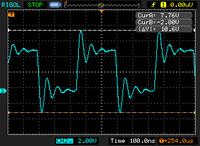PeterTr
Newbie level 6
Hello,
I was wondering what the explanation for the following observation is:
When looking with an oscilloscope at the clock signal that I generate with a microcontroller I do _not_ see an expected amplitude range of 0V to 5V but a large overshoot blow 0V and above 5V. See attached image. Are these amplitude real or just some sort of artefact due the interaction of the input stage of the oscilloscope with the steep transients ? If they are real, can they damage other components that are driven by this clock?
Thank you!
Peter

I was wondering what the explanation for the following observation is:
When looking with an oscilloscope at the clock signal that I generate with a microcontroller I do _not_ see an expected amplitude range of 0V to 5V but a large overshoot blow 0V and above 5V. See attached image. Are these amplitude real or just some sort of artefact due the interaction of the input stage of the oscilloscope with the steep transients ? If they are real, can they damage other components that are driven by this clock?
Thank you!
Peter
